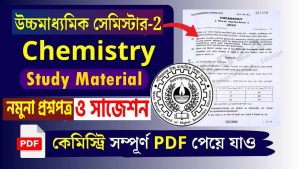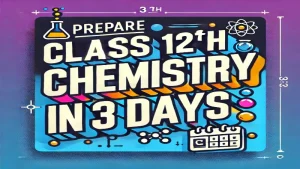1.Lithium has a bcc structure. Its density is 530 kg m–3 and its atomic mass is 6.94 g mol–1. Calculate the edge length of a unit cell of Lithium metal (NA = 6.02 × 1023 mol–1)[NEET 2016]
- (A) 527 pm
- (B) 264 pm
- (C) 154 pm
- (D) 352 pm
2.The ionic radii of A+ and B– ions are 0.98 ×10–10 m and 1.81 × 10–10 m. The coordination number of each ion in AB is [NEET 2016]
- (A) 8
- (B) 2
- (C) 6
- (D) 4
3.In a solid lattice the cation has left a lattice site and is located at an interstitial position, the lattice defect is [AIIMS 1982& 1991; DCE 2002; J & K 2005]
- Interstitial defect
- Valency defect
- Frenkel defect
- Schottky defect
4.Schottky defect defines imperfection in the lattice structure of a [AIIMS 2002]
- Solid
- Liquid
- Gas
- Plasma
5.Ionic solids, with Schottky defects, contain in their structure [CBSE-PMT=1994]
- Equal number of cation and anion vacancies
- Anion vacancies and interstitial anions
- Cation vacancies only
- Cation vacancies and interstitial cations
6.Which one of the following has Frenkel defect [MP-PMT=2000]
- Sodium chloride
- Graphite
- Silver bromide
- Diamond
7.Point defects are present in [MP-PMT=1997]
- Ionic solids
- Molecular solids
- Amorphous solids
- Liquids
8.Which one of the following crystals does not exhibit Frenkel defect [MP PET 2002]
- AgBr
- AgCl
- KBr
- ZnS
9.Body centered cubic lattice has a coordination number of [AIIMS=1996; MP-PMT=2002]
- (A) 4
- (B) 8
- (C) 12
- (D) 6
10.A compound is formed by elements A and B. This crystallizes in the cubic structure when atoms A are the corners of the cube and atoms B are at the centre of the body. The simplest formula of the compounds is [KCET 1993; CBSE PMT 2000; Kerala PMT 2002]
- (A) AB
- (B) AB2
- (C) A2B
- (D) AB4
11.In a cubic structure of compound which is made from X and Y, where X atoms are at the corners of the cube and Y at the face centres of the cube. The molecular formula of the compound is [AIIMS 2000]
- (A) X2Y
- (B) X3Y
- (C) XY2
- (D) XY3
12.Ferrous oxide has a cubic structure and each edge of the unit cell is 5.0 Å. Assuming density of the oxide as 4.0g/cm−3, then the number of Fe2+ and O2− ions present in each unit cell will be [MP PET 2000]
- A) Four Fe2+ and four O2−
- B) Two Fe2+ and four O2−
- C) Four Fe2+ and two O2−
- D) Three Fe2+ and three O2−
13.In CsCl structure, the coordination number of Cs+ is [MP PMT 2001]
- A) Equal to that of Cl− , that is 6
- B) Equal to that of Cl− , that is 8
- C) Not equal to that of Cl− , that is 6
- D) Not equal to that of Cl− , that is 8
14.Most crystals show good cleavage because their atoms, ions or molecules are [CBSE PMT 1991]
- A) Weakly bonded together
- B) Strongly bonded together
- C) Spherically symmetrical
- D) Arranged in planes
15.What is the coordination number of sodium in Na2O [AIIMS 2003]
- A) 6
- B) 4
- C) 8
- D) 2
16.The number of atoms present in unit cell of a monoatomic substance of simple cubic lattice is [Pb. PMT 2004]
- A) 6
- B) 3
- C) 2
- D) 1
17.The coordination number of a metal crystallizing in a hexagonal close packed chep structure is [MP PMT 2004]
- A) 12
- B) 8
- C) 4
- D) 6
18.An element occurring in the bcc structure has 12.08×1023 unit cells. The total number of atoms of the element in these cells will be [MP PET 1994]
- A) 24.16×1023
- B) 36.18×1023
- C) 6.04×1023
- D) 12.08×1023
19.For an ionic crystal of the general formula AX and coordination number 6, the value of radius ratio will be [MP PMT 1993]
- A) Greater than 0.73
- B) In between 0.73 and 0.41
- C) In between 0.41 and 0.22
- D) Less than 0.22
20.The number of atoms in 100g of an fcc crystal with density d=10g/cm3 and cell edge equal to 100pm, is equal to [CBSE PMT 1994; KCET 2002]
- A) 4×1025
- B) 3×1025
- C) 2×1025
- D) 1×1025
21. In the crystals of which of the following ionic compounds would you expect maximum distance between centres of cations and anions [CBSE PMT 1998]
- A) LiF
- B) CsF
- C) CsI
- D) LiI
22.The number of unit cells in 58.5g of NaCl is nearly [MP PMT 2000, 01]
- A) 6×1020
- B) 3×1022
- C) 1.5×1023
- D) 0.5×1024
23.In the Bragg?s equation for diffraction of X-rays, n represents for [MP PMT 2000]
- A) Quantum number
- B) An integer
- C) Avogadro?s numbers
- D) Moles
NEET MCQs Solution
15.Correct Answer: B Solution : In Na2O, each oxide ions (O2−) is co-ordinated to 8Na+ ions and each Na+ ion to 4 oxide ions. Hence it has 4 : 8 co-ordination.
16.Correct Answer: D Solution : In a simple cubic structure z=18×8(atoms one at a corners) z=1
17.Correct Answer: A Solution : Co-ordination number in hcp structure is 12.
18.Correct Answer: A Solution : There are two atoms in a bcc unit cell. So, number of atoms in 12.08×1023 unit cells =2×12.08×1023 =24.16×1023atom
19.Correct Answer: B Solution :The structural arrangement of co-ordination number ?6? is octahedral and its radius ratio is 0.414−0.732 . The example of octahedral is KCl and NaCl
20. Correct Answer: A
21. Correct Answer: c
22. Correct Answer: C
23 .Correct Answer: B Solution : Bragg?s equation is nλ=2dsinθ where n is an integer i.e. 1, 2, 3, 4 etc.







